Physical Development in Preschool Children
Chapter Objectives
After this chapter, you should be able to:
- Examine physical changes that take place in preschool children.
- Summarize how to support the progression of motor skills with age-appropriate activities.
- Discuss brain development in preschool children.
- Discuss sleep and nutrition needs during the preschool years
- Discuss risks of and a variety of ways to promote and protect children’s health and safety.
Introduction
Children between the ages of 3-5 are often referred to as preschoolers during this time period, and their physical growth typically progresses in a predictable sequence between milestones. Each child grows and develops at their own pace and may meet advanced milestones in one area (e.g., motor development) but may be still developing in another area, such as language (HealthLinkBC, 2021).
“Children usually learn to sit before walking and running, babble before talking, and scribble before drawing faces and printing letters. New learning and skills build on earlier changes. Each skill is necessary for the next emerging skills” (Best Start Expert Panel on Early Learning, 2007, p. 21).
We’ll examine the physical changes of the preschooler in this week’s reading.
Growth in Early Childhood
Preschool aged children tend to grow about 5-8cms (1.5 to 3 inches) in height each year and gain about around 2kg (4 to 5 pounds) in weight each year (HealthLinkBC, 2021, Kail & Zolner, 2020) . A 3 year old is very similar to a toddler with a large head, large stomach, short arms and legs. But by the time the child comes out of this stage, their torso has lengthened, and their body proportions have become more like those of adults. According to the World Health Organization (WHO; 2021), the average 5 year old weighs approximately 43 pounds and is about 43 inches in height. This growth rate is slower than that of infancy.
Expectations and development can be cultural, and our understanding in Canada can be different than other cultures and countries. Keep this in mind when exploring milestones, they are only guidelines and need to be adapted to be inclusive.
Indigenous Perspectives
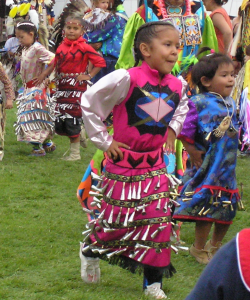
“Children hold a sacred place in the cultures of Indigenous peoples” (Indigenous Early Learning and Child Care Framework, 2018 p. 3).
Indigenous children love to dance with or without their Regalia (outfits). Their spirit soars when they dance. It gives them a sense of belonging and connects them to mother earth. It also reinforces what the Continuum of Development says [the development of gross motor skills focuses on increasing coordination, speed, and endurance]. As they have been watching the adults dance, young children’s dance movements really improve at this age.
Reconciliation
“The Government of Canada is committed to achieving reconciliation with Indigenous peoples.
This Indigenous Early Learning and Child Care Framework and the collaborative work to implement it over time responds to the Truth and Reconciliation Commission of Canada’s Call to Action #12 to develop culturally appropriate early childhood education programs for Indigenous families” (Indigenous Early Learning and Child Care Framework, 2018 p. 7).
With that comes a sacred responsibility to care for them. High-quality, culturally-specific and well-supported early learning and child care (ELCC) programs, services and supports that are specifically designed for and with Indigenous families and communities will make a genuine difference in the early experiences of children. This, in turn, will support children’s development and life outcomes. High-quality Indigenous ELCC programming empowers young children with a strong sense of identity. It provides educational opportunities and school readiness and contributes to their overall health and wellness from early years into adulthood.
Want to learn more? Read the Indigenous Early Learning and Child Care Framework, 2018.
Brain Development
Brain growth slows during the preschool years. The brain is about 75% its adult weight by two years of age and by age 6, it is approximately 95% its adult weight. Myelination and the development of dendrites continues to occur in the cortex and as it does, we see a corresponding change in the child’s abilities.
Significant development in the prefrontal cortex (the area of the brain behind the forehead that helps us to think, strategize, and control emotion) makes it increasingly possible to control emotional outbursts and to understand how to play games. Having said that, this area of the brain is the last to develop fully, and continues developing into the mid- to late-20s (Kail & Zolner, 2020).
Between ages 3 and 6, the left hemisphere of the brain grows dramatically. This side of the brain or hemisphere is typically involved in language skills. The right hemisphere continues to grow throughout early childhood and is involved in tasks that require spatial skills such as recognizing shapes and patterns. The corpus callosum which connects the two hemispheres of the brain undergoes a growth spurt between ages 3 and 6 and results in improved coordination between right and left hemisphere tasks. This demonstrates how development in preschool-aged children is so interconnected!
Consider 4- or 5-year-old children and how they might approach a game of soccer. Chances are, every move would be a response to the commands of a coach standing nearby calling out, “Run this way! Now, stop. Look at the ball. Kick the ball!” And when the child is not being told what to do, he or she is likely to be looking at the clover on the ground or a dog on the other side of the fence! Understanding the game, thinking ahead, coordinating movement, and handling losing improve with practice and myelination (Lumen Learning, n.d.).
Motor Skill Development
Preschool is a time when children are especially attracted to motion and song. Days are filled with jumping, running, swinging and clapping and every place becomes a playground. Even the booth at a restaurant affords the opportunity to slide around in the seat or disappear underneath and imagine being a sea creature in a cave! Of course, this can be frustrating to a caregiver, but it’s the business of working with preschool children.
Gross Motor Skills
Children continue to improve their gross motor skills as they run and jump. They frequently ask their caregivers to “look at me” while they hop or roll down a hill. Children’s songs are often accompanied by arm and leg movements or cues to turn around or move from left to right.
Gross Motor Milestones
The Continuum of Development shares that during the preschool years the development of gross motor skills focus on increasing in coordination, speed, and endurance (Ontario Ministry of Education, 2014). Specifically, the following motor movements are being refined:
- Walking: beginning to walk with opposite leg-arm swing, walking up stairs with alternating feet, walking down stairs with alternating feet
- Jumping: jumping increases in co-ordination
- Hopping: hopping on one foot increases
- Galloping: galloping and one-foot skipping emerge
- Throwing: throwing with rigid movements and throwing with increased co-ordination
- Riding: pedaling and steering riding toys, and riding a tricycle smoothly
- Movement and Expression: increasing control over own movements skills, becoming expressive using movement, expressing moods in movement, moving to music, matching movements to the rhyme and mood of the music, making patterns while moving to music, working together in shared dance and movement activities.
(Ontario Ministry of Education, 2014)
Activities to Support Gross Motor Skills
Here are some activities focused on play that young children enjoy and that support their gross motor skill development.
|
|

Movement
“At least 180 minutes spent in a variety of physical activities spread throughout the day, of which at least 60 minutes is energetic play—more is better” (ParticipAction, 2022).
Fine motor skills
Fine motor skills are also being refined as they continue to develop more dexterity, strength, and endurance. Fine motor skills are very important as they are foundational to self-help skills and later academic abilities (such as writing).
Fine Motor milestones
The Continuum of Development shares that during the preschool years the development of fine motor skills focus on the following:
- Dressing: mastering simple items of clothing; dressing without assistance.
- Eating: eating using forks and knives.
- Tool Use: stringing large beads, cutting paper with scissors, cutting a straight line.
- Drawing: copying straight lines, copying triangles and crosses.
(Ontario Ministry of Education, 2014)
Activities to support fine motor skills
There are many fun activities that will help children continue to refine their fine motor abilities. Fine motor skills are slower to develop than gross motor skills, so it is important to have age-appropriate expectations and play-based activities for children.
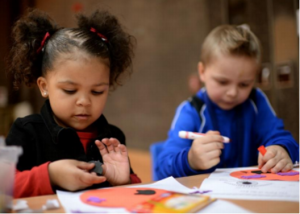
- Pouring water into a container
- Drawing and colouring
- Using scissors
- Finger painting
- Fingerplays and songs (such as the Itsy, Bitsy Spider)
- Play dough
- Lacing and beading
- Practicing with large tweezers, tongs, and eye droppers
Vision and Visual Pathways
Not Marvel’s Vision… we’re talking about the development of the eyes! Children’s drawings are representative of the development of visual pathways; as children’s brains mature the images in their drawings change. Early scribbles and dots illustrate the use of simple motor skills. No real connection is made between an image being visualized and what is created on paper.
At age 3, the child begins to draw wispy creatures with heads and not much other detail. Gradually pictures begin to have more detail and incorporate more parts of the body. Arm buds become arms and faces take on noses, lips and eventually eyelashes.
The Ontario Blind-Low Vision Early Intervention Program (2023) which offers resources, interventions, and supports for families, recommends children in Ontario have their first eye exam at 6-months of age, and then their second at ages 2-3 years. After age 3, they recommend annual exams. Working with families and healthcare practitioners, the Program supports education for families and professionals and promotes eye and vision health.
A Child who is blind or has low vision would not necessarily follow the stages of drawing outlined in the next section. How else might you as a CYCP assess fine and gross motor skills? How can you adapt activities and experiences to be inclusive?
Stages of Drawing
By 2 years of age, children clearly demonstrate their preference in using either their right or left hand to do things like brushing their teeth, colouring, or doing up a zipper; almost 90% of children prefer to use their right hand for fine-motor skills activities (Kail & Zolner, 2020).
Children’s drawings also progress with age, and there are three stages that children’s drawings can typically be categorized within.
The following stages are adapted from Martin (2001), Zero to Three (2017), Kail and Zolner (2020), and Sprouts Development (2021).
Pre-Schematic stage

Stage 1: (15 months to 2.5 years) early, basic, or random scribbles
- kids are still figuring out how their bodies move, and their drawings of lines and scribbles reflect this
- movements come primarily from the shoulder, holding their pencil, crayon, brush, etc. in their fist
- drawing and painting is exciting for many kids at this age, they’re making stuff!
- depending on brain development and sensory processing, a child may not like to draw or finger-paint at this stage, but this skill will develop later
- 20 basic scribbles are seen at this stage – circular, vertical, horizontal, and zigzag scribbles


Stage 2: (2-3 years) late/controlled scribbling
- come along with greater muscle control and increase in fine motor skills
- scribbles at this stage become more defined
- lines become clearer, patterns begin to emerge
Schematic Stage

As children further develop their fine-motor skills, their drawings continue to become more defined, and drawings become more recognizable.
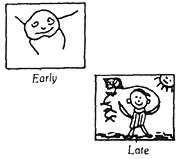
Stage 3: (2.5 to 3.5 years) Shapes, patterns, and tadpoles (early stage)
- children are beginning to recognize and copy letters
- shapes such as a person (looking more like a tadpole) can be identified in drawings
- drawings include more patterns, curves and basic shapes e.g., squares and rectangles
- triangles are a bit tricky at this stage!
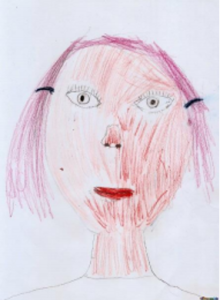
Stage 4: (3-5 years) Objects and people (late stage)
- children begin planning their drawings and putting thought into their artwork
- drawings include a house, a park, plants, flowers, cars and trucks, etc.
- drawings can be irregular and exaggerated, but they are identifiable
Realistic Stage
Drawing continues to develop, just as children continue growing. Later years lead to the realistic stage – more on that in the coming weeks!
Sleep and Nutrition
Nutrition
Dietitians of Canada (2020) have published tips on their website, UnlockFood.ca with more information on meal planning with preschool kids.
Preschoolers between the ages of 3 and 5 can eat a variety of healthy foods, and they can eat the same foods as adults. Provide food options with a range of textures, as well as colours (based on Canada’s Food Guide). Meals and snacks should take place around the same time everyday, so a child will be hungry around when meals happen.
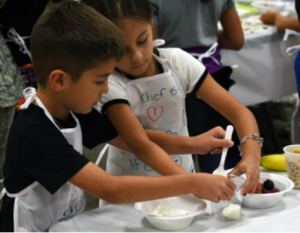
Children should be given the opportunity to decide how much to eat from the foods you offer. Don’t force a child to eat or restrict the amount of food you allow them to eat, the amount they eat -as well as their appetites- can change daily.
Use the suggestions and tips as general guidelines, and these should be adapted and adjusted for cultural and individual needs.
Children who develop at a slower rate compared to other children their age can also experience a reduced appetite between the ages of 2 and 5 years.
Tips for establishing healthy eating habits
There are several resources available for caregivers and professionals to support developing healthy eating habits for children. Canada’s Food Guide (Health Canada, 2023) offers healthy eating tips for parents and children and Leon (n.d.) provides additional description: Tips for Establishing Healthy Eating Patterns
Sleep
Along with food and water, sleep is one of the human body’s most important physiological needs—we cannot live without it. Extended sleeplessness (i.e., lack of sleep for longer than a few days) has severe psychological and physical effects. Research on rats has found that a week of no sleep leads to loss of immune function, and two weeks of no sleep leads to death (as cited in Pye, Scoffin, Quade & Kried, 2022). Recently, neuroscientists have learned that at least one vital function of sleep is related to learning and memory. New findings suggest that sleep plays a critical role in flagging and storing important memories, both intellectual and physical, and perhaps in making subtle connections that were invisible during waking hours (Leon, n.d.).
How much sleep do we need?
The amount of sleep an individual needs varies depending on multiple factors including age, physical condition, psychological condition, and energy exertion. Just like any other human characteristic, the amount of sleep people need to function best differs among individuals, even those of the same age and gender.
Though there is no magic sleep number, there are general rules for how much sleep certain age groups need. According to SickKids (2020) and ParticipAction (2023), during the preschool years, children are sleeping approximately 10-13 hours each day, including naps, with most of the sleep occurring in one large chunk at night.
This change in sleep patterns means that daytime naps will be dropped organically or weaned in order to make room for that important nighttime sleep. This may be a challenging time for children and their families as they respond to the transition. Some children may struggle to remain awake during the latter part of the day and may need extra support to regulate their behaviours and emotions during this stressful period. If the child attends a full day child care program, it is essential that the family and the educators work together to develop a sleep strategy designed in the best interest of the child.
Issues with Sleep
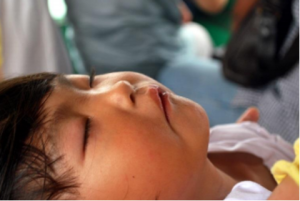
Sleepwalking (Somnambulism)
Sleepwalking (sometimes called sleepwalking disorder, somnambulism, or noctambulation) causes a person to get up and walk during the early hours of sleep. The person may sit up and look awake (though they’re actually asleep), get up and walk around, move items, or dress or undress themselves. They will have a blank stare and still be able to perform complex tasks. Some individuals also talk while in their sleep, saying meaningless words and even having arguments with people who are not there. A person who sleepwalks will be confused upon waking up and may also experience anxiety and fatigue.
According to Healthline (2018), sleepwalking is most common in children aged 4-8. Most children who sleepwalk begin to do so an hour or two after falling asleep and episodes usually last from five to 15 minutes. This behaviour is typically harmless, and most children grow out of it. However, it can be dangerous if left unaddressed. It’s important to protect your child from possible injury from sleepwalking by gently guiding them back to bed once discovered. Do not try to wake the sleepwalker, as this could aggravate them. Instead, simply reassure the child with words and help steer them back to bed.
Night Terrors and Nightmare Disorder
Night terrors are characterized by a sudden arousal from deep sleep with a scream or cry, accompanied by some behavioural manifestations of intense fear. They are often accompanied by sleep walking. Night terrors typically occur in the first few hours of sleep, during stage 3 NREM sleep and tend to happen during periods of arousal from delta sleep (i.e., slow-wave sleep).
According to the Hospital for Sick Children (SickKids; 2011), unlike nightmares, children who have night terrors rarely wake up during the episode. They often do not have memories of the night terror. During the episode, they will show signs of fear, anxiety and general disturbance. Children are typically not fully conscious and may speak without making sense. Night terrors are common in children younger than six years old.
You will learn more about sleep disorders in your mental health courses throughout the program.
Toilet Training (or Toilet Learning)
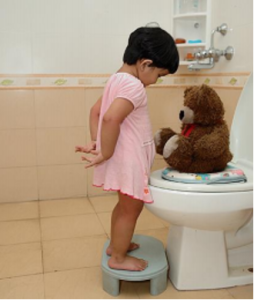
Learning how to use the toilet typically occurs between the ages of 2-4. Some children show interest by age 2, but others may not be ready until months later. The average age for girls to be toilet trained is 29 months and for boys it is 31 months, and 98% of children are trained by 36 months (Boyse & Fitzgerald, 2010, as cited in Paris, Ricardo, Raymond, & Johnson, 2021). The child’s age is not as important as his/her physical, emotional and cognitive readiness. If started too early, it might take longer to support a child in learning how to use the toilet.
According to the Canadian Paediatric Society via Caring for Kids (2018), caregivers can assume that a child is ready for toilet learning when they:
- Show an interest in the potty (by watching you, or by liking books about learning to use the potty).
- Are dry in their diaper for several hours in a row.
- Have regular and predictable bowel movements or knows when they are urinating or having a bowel movement. For example, child might go into another room or hide behind furniture
- Are steady and balanced when sitting on the toilet or potty.
- Can follow one or two simple instructions.
- Can let you know when they need to use the potty.
- Want to be independent.
Elimination Disorders
Some children experience elimination disorders including:
- enuresis – the repeated voiding of urine into bed or clothes (involuntary or intentional) after age 5
- encopresis – the repeated passage of feces into inappropriate places (involuntary or intentional).
The prevalence of enuresis is 5%-10% for 5 year-olds, 3%-5% for 10 year-olds and approximately 1% for those 15 years of age or older. Around 1% of 5 year-olds have encopresis, and it is more common in males than females. These are diagnosed by a medical professional and may require treatment (Lally & Valentine-French, 2019).
You will learn more about elimination disorders in your mental health courses throughout the program.
Health in early childhood
Childhood obesity
Childhood obesity is a complex health issue. It is diagnosed when a child is well above the normal or healthy weight for his or her age and height. Childhood obesity is on the rise; obesity rates among children and youth in Canada have nearly tripled in the last 30 years (Government of Canada, 2019). Where people live can affect their ability to make healthy choices. Obesity disproportionally affects children from low-income families.
Causes of obesity

The causes of excess weight gain in young people are similar to those in adults, including factors such as a person’s behaviour and genetics.
Behaviours that influence excess weight gain can include:
- eating high calorie, low-nutrient foods
- not getting enough physical exercise
- sedentary activities (such as watching television or other screen devices)
- medication use
- sleep routines
Consequences of obesity
The consequences of childhood obesity are both immediate and long term. It can affect physical as well as social and emotional well-being, and have immediate and long-term impacts. The Government of Canada (2019) describes these impacts in more details. If you would like to learn more, read on: Childhood Obesity
To fight off the risk of obesity in preschool aged children, the Government of Canada (2019) suggests that caregivers support children in developing healthy eating habits and encourage physical activity.
Food allergies and intolerance
According to Food Allergy Canada (2021),
- more than 3 million Canadians self-report having at least one food allergy.
- almost 500,000 Canadian children under 18 years have food allergies.
- peanut allergies in Canada affect about 2 in 100 children.
A food allergy occurs when the body has a specific and reproducible immune response to certain foods. Although the immune system normally protects people from germs, in people with food allergies, the immune system mistakenly responds to food as if it were harmful. The body’s immune response can be mild, moderate, severe or life-threatening. An example of a severe or life-threatening response would be anaphylaxis. Anaphylaxis is a sudden and severe allergic reaction that may cause death. Children at risk of anaphylaxis will likely have immediate access to an epinephrine auto-injector (e.g. EpiPen®, ALLERJECT®) which contains life-saving medication to treat an allergic reaction. Under Sabrina’s Law, every school board in Ontario is required to establish and maintain an anaphylactic policy. The law also requires schools to create individual plans for each child at risk of anaphylaxis.
Some preschool children may not have diagnosed food allergies, rather suffer from food intolerances. A food intolerance is the inability to digest or absorb certain foods. For example, someone with lactose intolerance doesn’t have enough of the enzyme lactase to break down the sugar (lactose) in dairy products. The symptoms of food intolerance affect the gastrointestinal tract and can cause discomfort but are generally not life-threatening (Food Allergy Canada, 2021).
Want to learn more? Food Allergy Canada has published many resources such as Caring for a child with food allergy: A guide on what you need to know
The following are helpful resources to support physical development:
- Canada Food Guide (2023)
- 24-Hour movement guidelines (CSEP, 2021)
- ParticiPaction (2023)
Indigenous Perspectives
Poverty and the lack of access to healthy foods affect all remote Indigenous communities in Canada (recall our coverage of social determinants of health in previous readings). Healthy foods are so expensive that poor families cannot afford them.
Want to learn more? The following link opens a paper on Tackling Poverty in Indigenous Communities in Canada. The following blog The Challenge of Feeding the North discusses food insecurity in remote communities in Canada.
This is a problem that has been at the forefront since Indigenous people have been displaced onto reservations across the country.
The Truth and Reconciliation Commission of Canada (2022) and the National Centre for Truth and Reconciliation outline 94 Calls to Action that begin to address inequalities faced by Indigenous communities. Calls to Action #18-24 relate to health specifically.
Oral health
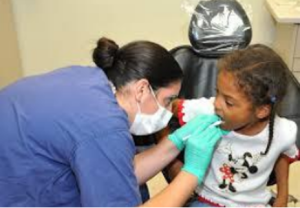
According to the Ontario Dental Hygienists’ Association (n.d.), teeth are an integral part of overall health and with proper care people can keep their teeth for a lifetime. Preschool aged children should be encouraged to build healthy eating habits to protect their teeth and encouraged to brush their teeth twice a day. When teeth are not well taken care of, children can suffer from oral infections and early childhood cavities: a severe form of tooth decay in the primary teeth of infants and toddlers. It affects more than 10% of preschool-age children in Canada.
Dental Hygiene Canada has a variety of resources including videos colouring sheets (age appropriate for preschool kids!) and activities to teach children about oral hygiene.
Protection from Illness
Two important ways to help protect children from illness are immunization and hand-washing.
Immunization
While vaccines begin in infancy (as was discussed in a previous reading), it is important for children to receive additional doses of vaccines to keep them protected. These boosters, given during the preschool years, are doses of the vaccines they received earlier in life to help them maintain the best protection against vaccine-preventable diseases.
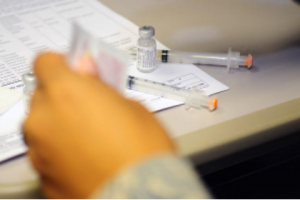
The following chart shows the recommended schedule of immunizations during childhood for the province of Ontario as of 2023. For the most current recommendations according to the National Advisory Committee on Immunization and for each province and territory go to the Government of Canada website Or for Ontario, recommendations through the Ministry of Health and Long Term Care website.

The Province of Ontario (2014), shares in the Child Care and Early Years Act, 2014 that families are to provide proof of immunization (or appropriate exemption documents) for certain diseases if their child attends a licensed childcare centre in Ontario.
A child may be exempt from immunization requirements for medical reasons, philosophical reasons or religious reasons.
It should be noted that children who are not vaccinated are at increased risk of disease and may be removed from the child care centre during a disease outbreak (Eastern Ontario Health Unit, 2021).
Hand-washing
Hand-washing is one of the best ways to prevent the spread of illness. It’s important for children (and adults) to wash their hands often, especially when they are likely to get and spread germs, including:
- Before, during, and after preparing food
- Before eating food
- After blowing nose, coughing, or sneezing
- After using the toilet
- After touching an animal, animal feed, or animal waste
- After touching garbage
It’s important for children to learn how to properly wash their hands. When washing hands children (and adults) should follow municipal and provincial health guidelines. Check out Toronto Public Health’s hand hygiene information as an example.

Caregivers can help keep children healthy by:
- Teaching them good hand-washing techniques.
- Reminding their kids to wash their hands.
- Washing their own hands with the children (Centres for Disease Control and Prevention, 2020).
Safety and childhood injury
Childhood injury is defined as “the physical damage that results when a human body is subjected to energy that exceeds the threshold of physiological tolerance or results in lack of one or more vital elements, such as oxygen” (Canadian Paediatric Society, 2020).
Through statistics shared via the Canadian Paediatric Society (2020),
- In Canada, injury is the leading cause of death for not only children, but for all Canadians between the ages of one and 44.
- Between 1994 and 2003, approximately 390 Canadian children age 14 years and under died from unintentional injuries annually, while another 25,500 were hospitalized.
- In 2004, injuries to Canadians cost $19.8 billion in health care costs and lost productivity, of which $16.0 billion resulted from unintentional causes. Of this, almost $3 billion could be accounted for by falls and transport-related injuries to children and youth from birth to 19 years of age.
The most common causes of injury in preschool aged children are due to the following:
- Falls: Falls are the leading cause of injury in preschool aged children. Examples of how falls can occur are as follows: on the stairs and steps, off furniture, by slipping, tripping and stumbling, by using furniture to climb out windows or balconies, by not using age appropriate playground equipment, and/or on hard surfaces.
- Choking, strangulation and suffocation are leading causes of injury-related deaths for children in Canada. Children can be harmed by: choking on food and small objects, strangling from items such as ropes, blind cords, or draw strings in clothing, suffocating in cribs or beds, being left in a car.
- Burns: A child’s skin burns four times faster and deeper than an adult’s at the same temperature. Common causes of burns include: scalds from steam, hot water, tipped-over coffee cups, hot foods or cooking fluids, contact with flames or other hot objects such as curling iron or fireplace, chemical burns from items such as batteries or bleach, electrical burns from biting on electrical cords or sticking fingers or objects into outlets, too much exposure to the sun.
- Poisoning: Half of all poison exposures happen to children under five years of age. Common poisonous products: medications, household cleaners, alcohol, plants, fertilizers, pesticides, paint thinner, antifreeze, carbon monoxide
- Drowning or near drowning: All children are at risk for drowning but children under age five have a higher risk. It can happen quickly and silently in only a few centimetres of water.
(City of Toronto, 2021)
Childhood injuries are preventable. It is important for caregivers to consistently and thoroughly supervise young children.
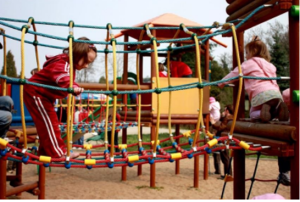
Summary
- The physical characteristics of preschoolers
- Healthy nutrition
- The changes in the brain
- The progression of motor skills and developmentally appropriate ways to support that development
- Sleep and sleep disorders
- Toilet training and elimination disorders
- And ways to keep children healthy and safe
Many of the details we covered in this week’s readings apply when we learn about cognitive, social, and development! We’ll build on these readings in the coming weeks.
References
Best Start Expert Panel on Early Learning. (2007). Early Learning for Every Child Today: A framework for Ontario early Childhood settings. Retrieved from http://betterbeginningssudbury.ca/wp-content/uploads/2015/09/continuum.pdf
Canadian Paediatric Society. (2020). Child and youth injury prevention: A public health approach. Retrieved from https://www.cps.ca/documents/position/child-and-youth-injury-prevention
Caring for Kids. (2018). Toilet learning. Retrieved from https://www.caringforkids.cps.ca/handouts/behavior-and-development/toilet_learning
City of Toronto. (2021). Common childhood injuries. Retrieved from https://www.toronto.ca/community-people/public-safety-alerts/safety-tips-prevention/home-high-rise-school-workplace-safety/child-safety/common-childhood-injuries/
Dental Hygiene Canada. (2023). Fun stuff! Retrieved from https://www.dentalhygienecanada.ca/DHCanada/For_Kids/Fun_Stuff/DHCanada/Kids/Fun_Stuff.aspx
Dietitians of Canada. (2020). Sample meal plan for feeding your preschooler (Ages 3 to 5). Retrieved from https://www.unlockfood.ca/en/Articles/Childrens-Nutrition/Cooking-and-Meal-Planning/Sample-meal-plan-for-feeding-your-preschooler-(age
Health Canada. (2023). Canada’s Food Guide. Retrieved from https://food-guide.canada.ca/en/
Healthline. (2018). Pediatric sleepwalking. Retrieved from https://www.healthline.com/health/sleep/sleepwalking-and-children
CSEP. (2021). Canadian 24 hour movement guidelines for the early years. Retrieved from https://csepguidelines.ca/early-years-0-4/
Eastern Ontario Health Unit. (2021). Immunization requirements for children in licensed child care centres (Daycare). Retrieved from https://eohu.ca/en/my-community/immunization-requirements-for-children-in-licensed-child-care-centres-daycare
Food Allergy Canada. (2021). Food allergy FAQ’s. Retrieved from https://foodallergycanada.ca/food-allergy-basics/food-allergies-101/food-allergy-faqs/
Government of Canada. (2019). Indigenous Early Learning and Child Care Framework. Retrieved from https://www.canada.ca/en/employment-social-development/programs/indigenous-early-learning/2018-framework.html
Government of Canada. (2019). Childhood obseity. Retrieved from https://www.canada.ca/en/public-health/services/childhood-obesity/childhood-obesity.html
HealthLinkBC. (2021a). Milestones for 4-year-olds. Retrieved from https://www.healthlinkbc.ca/pregnancy-parenting/parenting-preschoolers-3-5-years/preschooler-growth-and-development/milestones
HealthLinkBC. (2021b). Milestones for 5-year-olds. Retrieved from https://www.healthlinkbc.ca/pregnancy-parenting/parenting-preschoolers-3-5-years/preschooler-growth-and-development-3
HealthLinkBC. (2021c). Preschooler Development: 3-4 years. Retrieved from https://www.healthlinkbc.ca/pregnancy-parenting/parenting-preschoolers-3-5-years/preschooler-growth-and-development/preschooler.
Kail, R. V., & Zolner, T. (2020). Children: A Chronological Approach. 6th Canadian Ed. Pearson.
Lally, M. & Valentine-French, S. (2019). Lifespan development: A psychological perspective (2nd ed.). Retrieved from http://dept.clcillinois.edu/psy/LifespanDevelopment.pdf
Leon, A. (n.d.). Children’s development: Prenatal through adolescent development. Retrieved from https://docs.google.com/document/d/1k1xtrXy6j9_NAqZdGv8nBn_I6-lDtEgEFf7skHjvE-Y/edit
Lumen Learning. (n.d.). Physical development. In Lifespan development. Retrieved from https://courses.lumenlearning.com/lifespandevelopment2/chapter/physical-development-during-early-childhood/
Martin, P. P. (2001). Child art: A brief review of the developmental stages. CYC-Online (35). Retrieved from https://cyc-net.org/cyc-online/cycol-1201-martin.html
Ontario Blind-Low Vision Early Intervention Program. (2023). Retrieved from https://www.ontario.ca/page/blind-low-vision-early-intervention-program
Ontario Dental Hygienists’ Association. (n.d.). Dental hygiene facts: Oral care for children. Retrieved from https://odha.on.ca/wp-content/uploads/2016/08/ODHA-Facts-children.v2.pdf
Ontario Ministry of Education. (2014). Excerpts from “ELECT”. Retrieved from https://countrycasa.ca/images/ExcerptsFromELECT.pdf
ParticipAction. (2023). Early Years: Ages 0-4. Retrieved from: https://www.participaction.com/the-science/benefits-and-guidelines/early-years-0-to-4/
Province of Ontario. (2014). Child care and early years act 2014, O. Reg. 137/15: General. Retrieved from https://www.ontario.ca/laws/regulation/150137
SickKids. (2023). Immunization schedule for children. Retrieved from: https://www.aboutkidshealth.ca/immunization#
SickKids. (2020). Sleep: Benefits and recommended amounts. Retrieved from https://www.aboutkidshealth.ca/article?contentid=645&language=english
SickKids. (2011). Sleep terrors. Retrieved from https://www.aboutkidshealth.ca/Article?contentid=305&language=English
Sprouts Development. (2023). Early literacy: drawing and writing. Retrieved from: https://www.sproutsdevelopment.com/drawing-writing
Truth and Reconciliation of Canada. (2022). Delivering on Truth and Reconciliation Commission Calls to Action. Retrieved from https://www.rcaanc-cirnac.gc.ca/eng/1524494530110/1557511412801
World Health Organization. (2021). Weight for age (5-10 years). Retrieved from https://www.who.int/tools/growth-reference-data-for-5to19-years/indicators/weight-for-age-5to10-years
Zero to Three. (2017). Learning to Write and Draw. Retrieved from https://www.zerotothree.org/resource/learning-to-write-and-draw/
OER Attributions
Child Growth and Development Canadian Ed by Tanya Pye; Susan Scoffin; Janice Quade; and Jane Krieg is licensed under a Creative Commons Attribution-NonCommercial-ShareAlike 4.0 International License unless otherwise noted.
Child Growth and Development (Paris, Ricardo, Rymond, and Johnson)” by Paris, Ricardo, Raymond, & Johnson, The Child Growth and Development textbook is licensed under LibreTexts is licensed under CC BY 4.0 unless otherwise noted.
Lifespan Development by Lumen Learning is licensed under a Creative Commons Attribution-NonCommercial-ShareAlike 4.0 International License unless otherwise noted.

